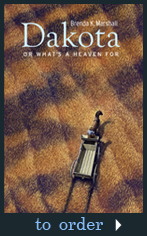Dakota, Or What’s a Heaven For: Resources
Writing a novel is, for me, neither linear nor efficient. A journal full of notes might ultimately be distilled into a line or a phrase; a book, underlined, highlighted and stuck full of post-it notes, may never again be picked up. But each makes its mark, obvious or not. Here is a short list of some of the resources I used while writing Dakota. Some helped me to understand the history of the territory, others to put the proper meals on tables and to farm with the right equipment. A few of the stories told in diaries and memoirs are echoed in my novel; some of them I had already heard, in one form or another, in kitchens or churches or bars throughout the Dakotas.
Writing this historical fiction also gave me the excuse to read 19th-century fiction for a couple of years, ostensibly to attune my ear to the spoken and written cadences of another era, but to tell the truth, this part was just plain fun. Some of the novels I read are the classics we regularly encounter. Some of the novels were contemporary favorites that have been forgotten. I reread George Eliot’s Middlemarch every seven or eight years because it is magnificent. Chances are very good that I won’t be rereading Dorcas: the Daughter of Faustina by Nathan C. Kouns anytime soon.
Selected Bibliography (nonfiction and fiction, informal, and in no particular order):
History of the Northern Pacific Railroad by Eugene Smalley (1883).
Compendium of History and Biography of North Dakota (Chicago: Geo. A. Ogle & Co., 1900)
The Early Empire Builders of the Great West by Moses K. Armstrong (St. Paul, Minnesota: E.W. Porter, 1901), compiled and enlarged from the author's Early History of Dakota Territory,1866.
Early History of North Dakota by Colonel Clement A. Lounsberry (Washington DC: Liberty Press, 1919)
Plains Folk: North Dakota’s Ethnic History, eds. William C. Sherman and Playford V. Thorson (North Dakota Institute for Regional Studies, 1988).
Dakota Territory, 1861-1889: A Study of Frontier Politics by Howard Roberts Lamar (Yale University Press, 1956; reprinted by North Dakota Institute for Regional Studies, 1996).
History of North Dakota by Elwyn B. Robinson (University of Nebraska Press, 1966)
Roy Johnson’s Red River Valley: A selection of historical articles first printed in ‘The Forum’ from 1941 to 1962, ed. Clarence A Glasrud (Red River Valley Historical Society, 1982)
The Day of the Bonanza: A History of Bonanza Farming in the Red River Valley of the North by Hiram M. Drache (Danville, Illinois: The Interstate Printers and Publishers, Inc., 1964)
The Challenge of the Prairie: Life and Times of Red River Pioneers by Hiram M. Drache (North Dakota Institute for Regional Studies, 1970)
Son of the Morning Star: Custer and The Little Bighorn by Evan S. Connell (North Point Press, 1984)
Lost Twin Cities by Larry Millett (St. Paul: Minnesota Historical Society, 1992)
Land in Her Own Name: Women as Homesteaders in North Dakota by H. Elaine Lindgrenn (North Dakota Institute for Regional Studies, Fargo, 1991)
Women of the Northern Plains by Barbara Handy-Marchello (Minnesota Historical Society, 2005)
The Checkered Years: Excerpts from the Diary of Mary Dodge Woodward, Written While Living on a Bonanza Farm in Dakota Territory During the Years 1884-1889 (reprinted by the Cass County Historical Society, no publication date in my copy)
“A Secret to Be Buried”: the Diary and Life of Emily Hawley Gillespie, 1858-1888 by Judy Nolte Lensink (Iowa City: University of Iowa Press, 1989)
Rachel Calof’s Story: Jewish Homesteader on the Northern Plains, translated from Yiddish by Jacob Calof and Molly Shaw (Indiana University Press, 1995)
Dakota Diaspora: Memoirs of a Jewish Homesteader by Sophie Trupin (Berkeley, CA: Alternative Press, 1984)
Nothing to Do But Stay: My Pioneer Mother by Carrie Young (University of Iowa Press, 1991)
Grass of the Earth: Immigrant Life in the Dakota Country by Aagot Raaen (Minnesota Historical Society Press, 1994; first published by the Norwegian-American Historical Association in 1950)
Giants in the Earth by O.E. Rolvaag (Harper & Brothers, 1927)
Websites: Looking back at the list of websites saved in my Favorites file, I see sites that I visited regularly (such as http://www.timeanddate.com/ so I could keep my characters’ calendars accurate) and sites that were useful for a day (for information about children’s toys in the nineteenth century or about Norwegian holidays, for example). This list reminds me, mostly, of paths not taken (or taken, written, deleted, lost), but, I’ll say it again: although much of what I read, researched, and learned did not find its way into the lines of the novel, that steady accrual of information was crucial to a certain emotional and historical truth of the time and place. Readers who enjoy Dakota, Or What’s a Heaven For may find much of interest in the following sites.
I was a frequent visitor to John Caron's Fargo history website, fargo-history.com, which has since been donated to the NDSU Archives. A pictorial history of Fargo, North Dakota, this website is a treasure-house of terrific photographs.
http://library.ndsu.edu/archives/ : This is the site for the North Dakota Institute for Regional Studies.
http://history.nd.gov/ : This is the site for the State Historical Society of North Dakota.
http://history.sd.gov/: This is the site for the South Dakota State Historical Society
http://www.mnhs.org/library/ : This is the site for the Minnesota Historical Society.


